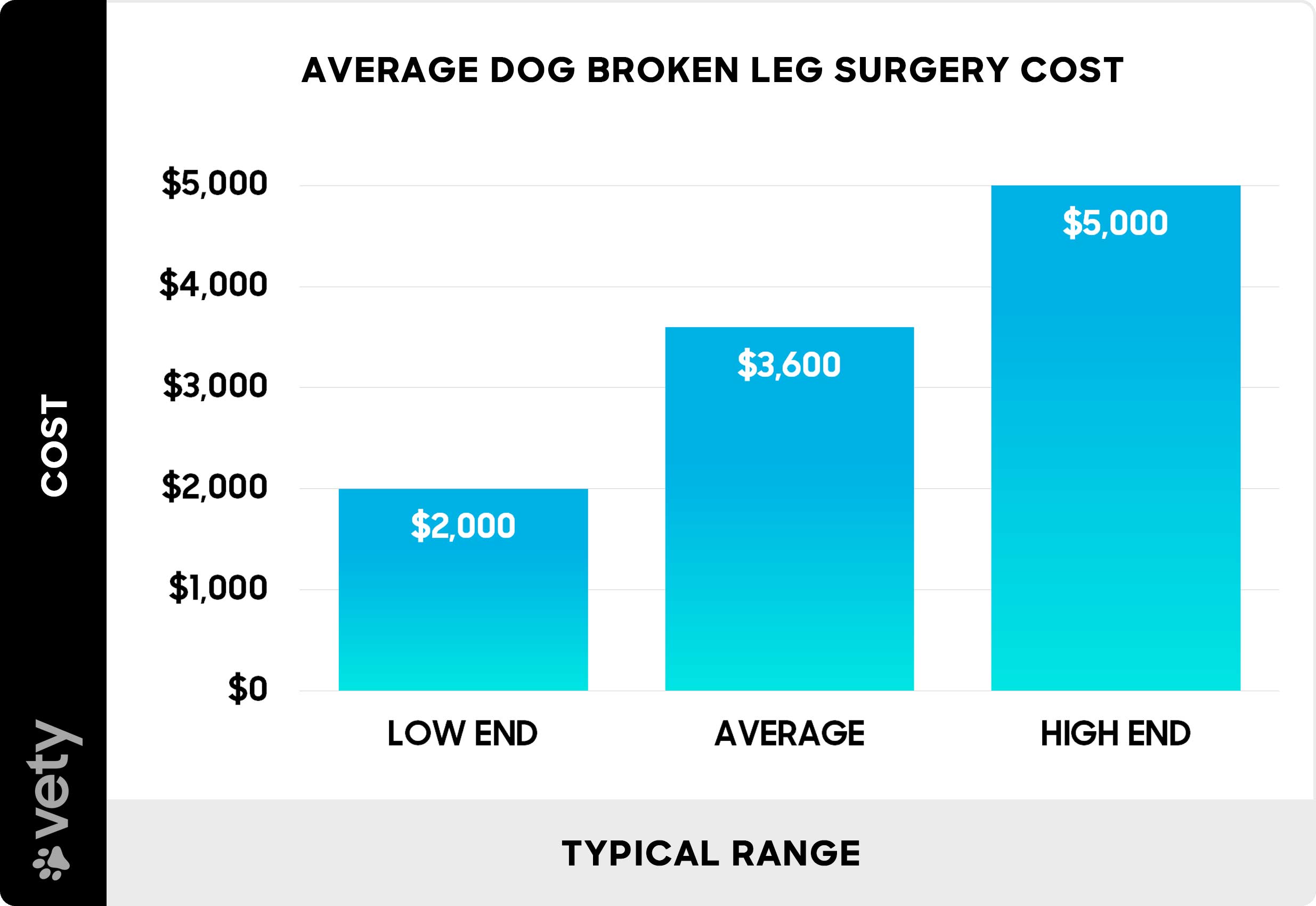
How much does dog broken leg surgery cost?
How much does dog broken leg surgery cost?
$2,000 – $5,000 average cost
Average dog broken leg surgery cost
Dog broken leg surgery costs $2,000 to $5,000 on average. The total cost depends on the fracture type and complexity, diagnostic testing and anesthesia fees, the type of veterinary clinic, and your location. Costs are higher for dogs that require additional post-operative care and physical therapy.

| National Average Cost | $3,600 |
| Minimum Cost | $1,000 |
| Maximum Cost | $9,000 |
| Average Range | $2,000 to $5,000 |
Surgery fees typically include a physical examination, anesthesia, the surgical procedure, and a follow-up exam. Some veterinarians include antibiotics and painkillers in their fee but may charge extra for blood work and X-rays.
Dog leg fracture surgery cost factors
Several factors affect the cost of surgery to repair a dog's broken leg:
Type of fracture
The complexity and severity of your dog's fracture significantly impact the surgical cost and treatment approach. Several types of fractures may occur in a dog's leg:
Incomplete fracture: Also known as a hairline fracture, this occurs when the bone cracks but doesn't break completely through. These fractures are less complex to treat and may heal with splinting or casting rather than surgery, resulting in lower costs.
Complete fracture: The bone breaks entirely into two or more pieces. These fractures require surgical intervention with plates, screws, or pins to properly align and stabilize the bone fragments.
Comminuted fracture: The bone shatters into multiple small pieces, making this one of the most complex and expensive fractures to repair. Surgeons must carefully reconstruct the bone using specialized hardware and techniques.
Open fracture: The broken bone pierces through the skin, creating an open wound. These fractures carry higher infection risks and require immediate surgical attention, extensive cleaning, and longer recovery periods.
Closed fracture: The bone breaks but doesn't penetrate the skin. While still requiring surgical repair, these fractures have lower infection risks and may cost less to treat than open fractures.
Salter-Harris fracture: This type of fracture affects the growth plate in young dogs and requires specialized surgical techniques to prevent future growth problems.
Articular fracture: The break extends into a joint, affecting cartilage and joint function. These fractures require specialized surgical techniques and may involve joint reconstruction or replacement.
Type of clinic
Specialty veterinary hospitals and emergency clinics charge more than general practice veterinarians. However, these facilities often have advanced equipment and experienced surgical staff that may be necessary for complex cases.
Location
Veterinary costs vary significantly by geographic location. Veterinary clinics and animal hospitals in major metropolitan areas and regions with a higher cost of living tend to charge more compared to those in rural areas.
Other costs
Additional expenses beyond the surgery itself can impact your total bill:
Pre-surgical tests: Your dog will likely need X-rays and blood work before the procedure. Some veterinarians include these costs in the surgery fee, while others charge separately for them.
Dog X-rays cost $150 to $250 per image and help the veterinarian determine the precise location and complexity of the fracture.
Dog blood work costs $100 to $200 and confirms your dog is healthy enough to undergo surgery.
Post-operative care: Recovery monitoring, wound care, and medication administration may require several days of hospitalization, increasing your total cost.
Pain medication: Post-surgical pain management medications are essential for your dog's comfort and healing process.
Splint or cast: External support devices may be necessary alongside or instead of surgery.
Elizabethan collar / cone: A cone costs $15 to $50 and prevents your dog from licking or chewing the surgical site.
Follow-up visits: Multiple post-operative checkups are necessary to monitor healing progress. Some veterinarians include follow-up visits in the surgical fee while others charge extra.
Physical therapy: Rehabilitation services help restore function and mobility but add to the cost.
How to tell if a dog's leg is broken
Recognizing the signs of a broken leg in your dog is crucial for prompt treatment and better outcomes. Dogs with fractured legs exhibit several distinct symptoms that require immediate veterinary attention.
Obvious signs of a broken leg include:
Visible bone protruding through the skin
Severe swelling or deformity of the limb
Complete inability to bear weight on the affected leg
Leg hanging at an unnatural angle
Subtle signs that may indicate a fracture:
Limping or favoring one leg while walking
Reluctance to move or play
Whimpering or crying when the leg is touched
Lethargy or decreased appetite due to pain
Difficulty getting up from lying down
If you suspect your dog has a broken leg, avoid moving them unnecessarily and seek immediate veterinary care. Attempting to treat the injury at home can worsen the fracture and complicate surgical repair.

FAQs about dog broken bone surgery
Does pet insurance cover dog broken leg surgery?
Most comprehensive pet insurance policies cover broken leg surgery as an accident-related injury. Coverage amounts vary by policy, but many plans reimburse 70% to 90% of eligible expenses after meeting your deductible. Pet insurance costs $35 to $75 per month.
Pet insurance policies exclude pre-existing conditions, so enrolling your dog in pet insurance before any injuries occur is essential. Some policies have waiting periods for accident coverage, so review your policy details carefully.
How long does a dog leg fracture take to heal?
Healing time depends on the fracture type, your dog's age and health, and the surgical technique used. Simple fractures in young, healthy dogs may heal in 6 to 8 weeks, while complex fractures in older dogs can take 12 to 16 weeks or longer.
Can a dog die from a broken leg?
While a broken leg alone is rarely fatal, complications can be life-threatening if the injury is left untreated. Open fractures carry infection risks that can lead to sepsis, while severe trauma may cause shock or damage to vital organs.
Prompt veterinary treatment significantly reduces these risks. Most dogs recover fully from broken leg surgery when treated appropriately and given proper post-operative care.
Can a dog walk on a broken leg?
Dogs may attempt to walk on a broken leg, especially if the fracture is incomplete or if adrenaline masks the pain initially. However, walking on a fractured limb can worsen the injury and complicate treatment. Restrict your dog's movement and seek immediate veterinary care if you suspect a fracture.
Questions to ask your vet
Ask your veterinarian these questions to ensure you understand the treatment options, surgical procedure, risks, and recovery process:
What type of fracture does my dog have, and what surgical approach do you recommend?
Are there any alternative treatment options to consider?
How long will the surgery take, and what anesthesia risks should I be aware of?
What post-operative care will my dog need at home?
What is the expected recovery timeline, and when can my dog return to normal activities?
Are there any complications I should watch out for during recovery?
Will my dog need physical therapy or rehabilitation services?
What pain management options are available for my dog?
How many follow-up appointments will be necessary?
What are the long-term prognosis and potential for full recovery?
What happens if complications arise during or after surgery?
What are the total estimated costs, including pre-surgical tests and post-operative care?